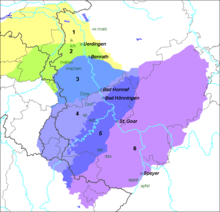| Revision as of 09:12, 31 December 2023 editSarcelles (talk | contribs)Autopatrolled, Extended confirmed users, Pending changes reviewers9,112 edits Content fitting to the Rhenish fan from Bergish dialects#Classification by CornelissenTag: Reverted← Previous edit | Revision as of 11:02, 31 December 2023 edit undoAustronesier (talk | contribs)Extended confirmed users, Pending changes reviewers26,187 edits Rv. Only marginally relevant to this article. See Talk:Bergish_dialects#Cornelissen's_classification.Tag: Manual revertNext edit → | ||
| Line 1: | Line 1: | ||
| {{Short description|Distinctive differences between neighbouring Renish dialects}} | {{Short description|Distinctive differences between neighbouring Renish dialects}} | ||
| The subdivision of ] into a series of dialects, according to the differing extent of the ], is particularly pronounced. It known as the Rhenish fan ({{lang-de|Rheinischer Fächer|links=no}}, {{lang-nl|Rijnlandse waaier|links=no}}) because on the map of dialect boundaries, the lines form a fan shape.<ref> {{webarchive |url=https://web.archive.org/web/20090215032712/http://www.rheinische-landeskunde.lvr.de/kompetenz/Sprache/rheinischer_sprachatlas/ |date=February 15, 2009 }}</ref> Here, no fewer than eight isoglosses, named after places on the ], run roughly west to east. They partially merge into a simpler system of boundaries in East Central German. The table below lists the isoglosses (bold, in light fields) and the main resulting dialects (italics, in dark fields), arranged from north to south. | The subdivision of ] into a series of dialects, according to the differing extent of the ], is particularly pronounced. It known as the Rhenish fan ({{lang-de|Rheinischer Fächer|links=no}}, {{lang-nl|Rijnlandse waaier|links=no}}) because on the map of dialect boundaries, the lines form a fan shape.<ref> {{webarchive |url=https://web.archive.org/web/20090215032712/http://www.rheinische-landeskunde.lvr.de/kompetenz/Sprache/rheinischer_sprachatlas/ |date=February 15, 2009 }}</ref> Here, no fewer than eight isoglosses, named after places on the ], run roughly west to east. They partially merge into a simpler system of boundaries in East Central German. The table below lists the isoglosses (bold, in light fields) and the main resulting dialects (italics, in dark fields), arranged from north to south. | ||
| In a classification by {{ill|Georg Cornelissen|de}} based on key isoglosses, dialects of the Bergisches Land are assigned to three dialect areas: varieties between the ] (northern ''ik'' vs. southern ''ich'' 'I') and the ] (northern ''maken'' vs. southern ''machen'' 'make') are grouped as ] (e.g. around ]), varieties south of the Benrath line are classified as ] (e.g. ]), while ''Ostbergisch'' ("East Bergish") designates a group of dialects in a long narrow stretch from ] to ] between the Uerdingen line (including its southeastern extension where it merges with the Benrath line east of ]) and the so-called ''Einheitsplurallinie'' (defined as the southwestern-most extension of the ] generalized plural verb suffix ''-t'').<ref>{{Cite web |title=Dialekte im Rheinland |publisher=LVR-Institut für Landeskunde und Regionalgeschichte |url=https://rheinische-landeskunde.lvr.de/de/sprache/sprache_themen/dialekte_beitrag.html |access-date=17 October 2023}}</ref> | |||
| ==Chart== | ==Chart== | ||
Revision as of 11:02, 31 December 2023
Distinctive differences between neighbouring Renish dialectsThe subdivision of West Central German into a series of dialects, according to the differing extent of the High German consonant shift, is particularly pronounced. It known as the Rhenish fan (Template:Lang-de, Template:Lang-nl) because on the map of dialect boundaries, the lines form a fan shape. Here, no fewer than eight isoglosses, named after places on the Rhine River, run roughly west to east. They partially merge into a simpler system of boundaries in East Central German. The table below lists the isoglosses (bold, in light fields) and the main resulting dialects (italics, in dark fields), arranged from north to south.
Chart

Low Franconian:
1 North Low Franconian
2 South Low Franconian
West Central German:
3 Ripuarian Franconian
4 & 5 Mosel Franconian
6 Rhenish Franconian
| Dialects and isoglosses of the Rhenish fan (Arranged from north to south: dialects in dark fields, isoglosses in light fields) | ||
| North Low Franconian (Kleverlandish, East Bergish) / Low German | ||
|---|---|---|
| Uerdingen line (Uerdingen) (Ürdinger Linie) |
ik/ick | ich |
| South Low Franconian (Limburgish) | ||
| Benrath line (Benrather Linie) (Boundary: Low German — Central German) |
maken | machen |
| Ripuarian Franconian (Cologne, Bonn, Aachen) | ||
(Dorp/Dorf-Linie or Eifel-Schranke/Eifelschranke) (State border NRW–RP) |
Dorp | Dorf |
| Northern Mosel Franconian (Luxemburgish, Trier) | ||
| up | uf | |
| Southern Mosel Franconian (Koblenz, Saarland) | ||
| Bacharach line (Bacharach) (dat/das-Linie or Hunsrück-Schranke/Hunsrückschranke or Bacharacher Linie) |
dat, wat | das, was |
| Rhenish Franconian (Pfälzisch, Frankfurt) | ||
| Speyer line (Speyer) (Speyrer Linie) (Boundary: Central German — Upper German) |
Appel | Apfel |
| Germersheim line (Germersheim) (Germersheimer Linie) (Boundary: Central German — Upper German) |
Pund | Pfund |
| Upper German | ||
Notes
- That is, it's arranged like this:
northern dialect Isogloss northern form southern form southern dialect
References
- Rheinischer Fächer – Karte des Landschaftsverband Rheinland Archived February 15, 2009, at the Wayback Machine
- LVR-Institut für Landeskunde und Regionalgeschichte (ed.). "Dialekte im Rheinland". Archived from the original on 7 December 2022. Retrieved 21 July 2023.. Compare also:
- LVR-Institut für Landeskunde und Regionalgeschichte (ed.). "Dialekte im Rheinland". Retrieved 21 July 2023.
- LVR-Institut für Landeskunde und Regionalgeschichte (ed.). "Kleverländisch/ Kleverlands". Retrieved 11 September 2023.
- LVR-Institut für Landeskunde und Regionalgeschichte (ed.). "Südniederfränkisch/ Zuidnederfrankisch". Retrieved 11 September 2023.
Map also printed in:
Winfried Dolderer, Overmaas – „jenseits der Maas“: Eine historische Annäherung, in: Sebastian Bischoff, Christoph Jahr, Tatjana Mrowka, Jens Thiel (eds.), „Mit Belgien ist das so eine Sache ...“: Resultate und Perspektiven der Historischen Belgienforschung (series: Historische Belgienforschung, Bd. 9), Waxmann, Münster / New York, 2021, p. 15ff., here p. 18.
- Johannes Venema, Zum Stand der zweiten Lautverschiebung im Rheinland: diatopische, diachrone und diastratische Untersuchungen am Beispiel der dentalen Tenuis (voralthochdeutsch /t/), Franz Steiner Verlag, 1997, p. 10–12.